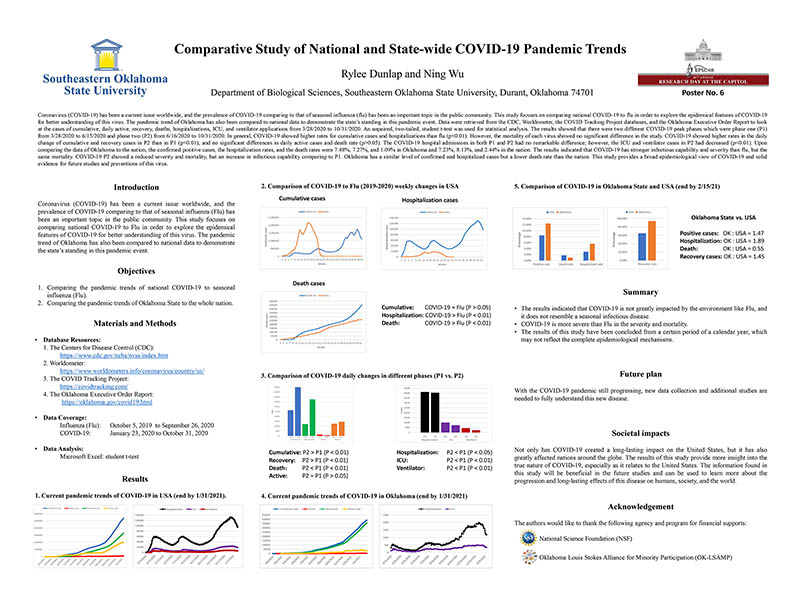
Hover to pan and click to magnify. Click again to pan at full screen.
Rylee K. Dunlap, Dept. of Biological Sciences, Southeastern Oklahoma State University, Durant, OK. Faculty Advisor, Dr. Ning Wu, Southeastern Oklahoma State University, Durant, OK.
Rylee K. Dunlap, Dept. of Biological Sciences, Southeastern Oklahoma State University, Durant, OK. Faculty Advisor, Dr. Ning Wu, Southeastern Oklahoma State University, Durant, OK.
ABSTRACT
Coronavirus (COVID-19) has been a current issue worldwide, and the prevalence of COVID-19 comparing to that of seasonal influenza (flu) has been an important topic in the public community. This study focuses on comparing national COVID-19 to flu in order to explore the epidemical features of COVID-19 for better understanding of this virus. The pandemic trend of Oklahoma has also been compared to national data to demonstrate the state’s standing in this pandemic event. Data were retrieved from the CDC, Worldometer, the COVID Tracking Project databases, and the Oklahoma Executive Order Report to look at the cases of cumulative, daily active, recovery, deaths, hospitalizations, ICU, and ventilator applications from 3/28/2020 to 10/31/2020. An unpaired, two-tailed, student t-test was used for statistical analysis. The results showed that there were two different COVID-19 peak phases which were phase one (P1) from 3/28/2020 to 6/15/2020 and phase two (P2) from 6/16/2020 to 10/31/2020. In general, COVID-19 showed higher rates for cumulative cases and hospitalizations than flu (p<0.01). However, the mortality of each virus showed no significant difference in the study. COVID-19 showed higher rates in the daily change of cumulative and recovery cases in P2 than in P1 (p<0.01), and no significant differences in daily active cases and death rate (p>0.05). The COVID-19 hospital admissions in both P1 and P2 had no remarkable difference; however, the ICU and ventilator cases in P2 had decreased (p<0.01). Upon comparing the data of Oklahoma to the nation, the confirmed positive cases, the hospitalization rates, and the death rates were 7.48%, 7.27%, and 1.09% in Oklahoma and 7.23%, 8.13%, and 2.44% in the nation. The results indicated that COVID-19 has stronger infectious capability and severity than flu, but the same mortality. COVID-19 P2 showed a reduced severity and mortality, but an increase in infectious capability comparing to P1. Oklahoma has a similar level of confirmed and hospitalized cases but a lower death rate than the nation. This study provides a broad epidemiological view of COVID-19 and solid evidence for future studies and preventions of this virus.

DISQUS COMMENTS WILL BE SHOWN ONLY WHEN YOUR SITE IS ONLINE